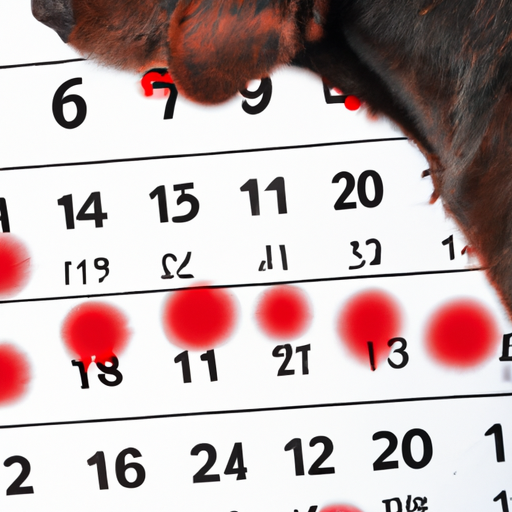Understanding The Canine Estrous Cycle
The first thing you need to understand is the canine estrous cycle. Just like humans, female dogs have their own reproductive cycle, but it’s not monthly. Instead, it’s typically twice a year. This is when your female dog would go through what’s often referred to as “heat” or “season”.
The cycle consists of four stages:
1. Proestrus: This is the start of the heat cycle. It typically lasts from 7 to 10 days. You might notice your dog’s vulva swelling and some spotting or bleeding. This is normal.
2. Estrus: This is when your dog is most fertile. It usually lasts about 9 days, but can range from 3 to 21 days. The bleeding will become less intense and change to a lighter, straw-like color.
3. Diestrus: This stage lasts about 60 to 90 days. The vulva returns to its normal size and any bleeding stops.
4. Anestrus: The final stage, lasting until the next heat cycle begins.
How Long Will My Dog Bleed?
Understanding the cycle is crucial to answering the question: “How long will my dog bleed?” During the proestrus and estrus stages, you can expect some form of discharge, which can include bleeding.
| Stage | Duration | Discharge |
|---|---|---|
| Proestrus | 7 to 10 days | Spotting/Bleeding |
| Estrus | 3 to 21 days | Lighter, straw-like color |
| Diestrus | 60 to 90 days | None |
| Anestrus | Until next cycle | None |
So, while it can vary from dog to dog, on average, a female dog will bleed for around two to three weeks.
What Should I Do While My Dog Is Bleeding?
While your dog is bleeding, it’s important to remember it’s a completely natural process. However, there are a few things you can do to help manage the situation:
- Use doggie diapers or pads: These can help manage the bleeding and keep your home clean.
- Limit interaction with male dogs: During this time, your female dog will be attractive to male dogs, which could lead to unwanted pregnancies.
- Regularly check for changes: Notice if there’s an increase in bleeding or if it lasts longer than usual, which could indicate a health issue.
What If The Bleeding Lasts Longer Than Expected?
If your dog’s bleeding lasts longer than three weeks, it could be a sign of a health issue. This could include conditions like pyometra, an infection of the uterus, or endometriosis, a condition where the lining of the uterus grows outside it. If you’re concerned about your dog’s bleeding, you should consult a vet immediately.
FAQ
Q: When does a female dog start her first cycle?
A: Most dogs have their first heat cycle between six and nine months of age, but it can vary depending on the breed and individual dog.
Q: Should I breed my dog during her first heat cycle?
A: Most experts recommend waiting until at least the third heat cycle to breed a dog.
Q: How can I tell if my dog is in heat?
A: You might notice swelling of the vulva, spotting or bleeding, and more frequent urination. Behavior changes such as increased affection or aggression can also be signs.
Q: Can a dog get pregnant during her first heat cycle?
A: Yes, a dog can get pregnant during her first heat cycle. However, it’s not recommended as it can pose health risks to both the mother and puppies.
Q: How often do dogs go into heat?
A: Most dogs go into heat approximately every six months, but it can vary depending on the breed and individual dog.
Remember, being a caregiver for a pet means understanding their bodies, behaviors, and needs. Empower yourself with knowledge to provide the best care possible for your furry friend.



